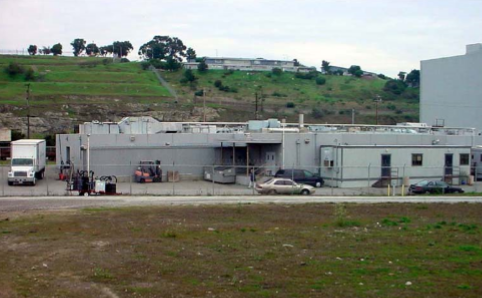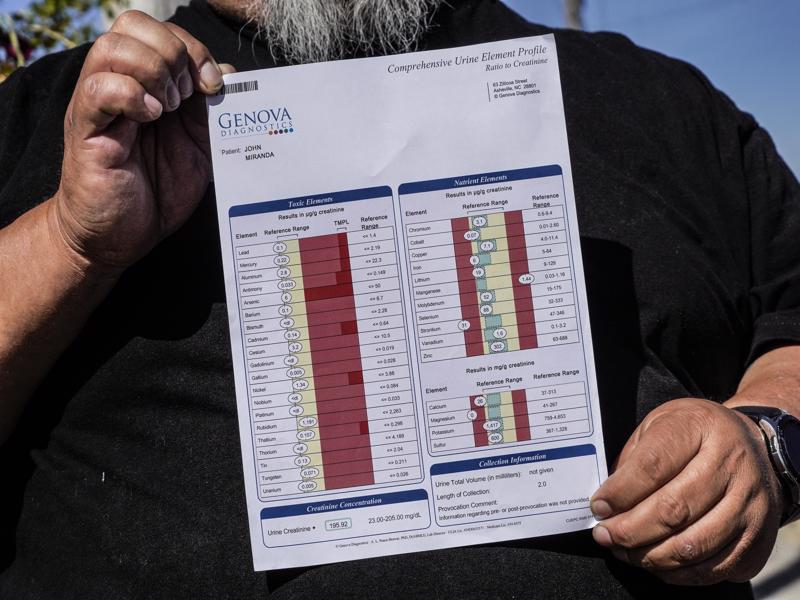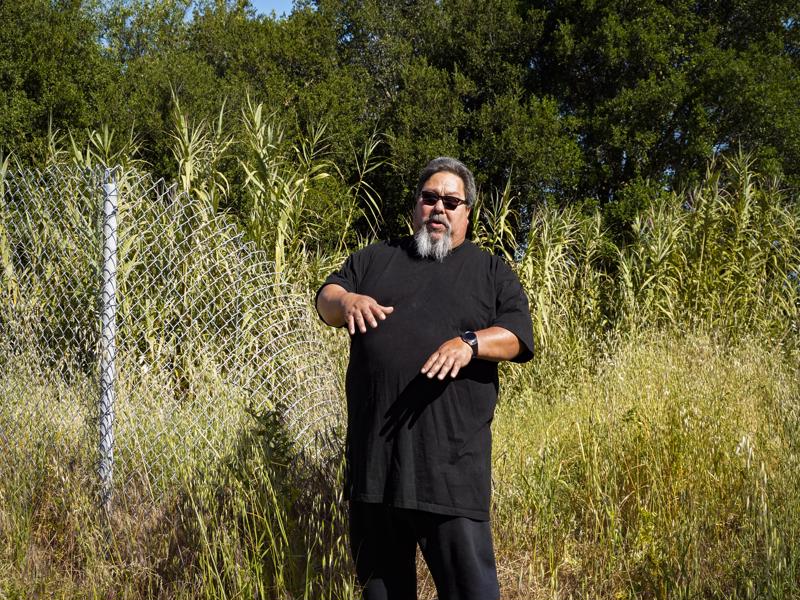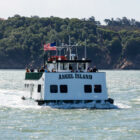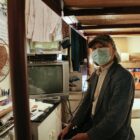A community health survey has identified elevated levels of harmful substances in workers and residents around Hunters Point. The Navy says its toxic and radioactive Superfund site isn’t the source, but experts agree more study is needed.
Only a chain-link fence separates John Miranda and Robert Little’s longtime workplace — the University of California, San Francisco, research animal colony on Crisp Road in Hunters Point — from the most polluted land in the city.
From the 1990s to the early 2010s, the men cleaned cages, tended to animals, cut grass, painted and cleared away dust blown in from the former U.S. Navy shipyard, a U.S. Environmental Protection Agency Superfund site and the focus of the largest real estate project in San Francisco history.
Retired and in their 50s, both men now suffer from a slew of health problems. Miranda, a lifelong nonsmoker, has asthma. Little developed hypertension and diabetes in his early 40s. Both wonder whether airborne pollutants from the old Naval base and the shipyard’s industrial landfill, located just a few yards away from the animal colony building, are what made them sick — and could explain why they’ve tested positive for heavy metals and other toxic substances.
Despite significant public and private investment to prepare the area for thousands of homes as well as community demands stretching back decades, little has been spent studying the shipyard’s impact on the health of people living or working nearby. Many complain of breathing trouble, cancers and thyroid problems consistent with exposure to pollution like the toxic heavy metals and radioactive waste known to be present at the shipyard.
For the first time, shipyard critics and environmental watchdogs have hard data that suggest shipyard contamination could have migrated into nearby homes and businesses, potentially sickening residents and workers.
Little and Miranda are two of the participants in a community biomonitoring survey, sponsored by Greenaction, an environmental justice nonprofit, and funded by the Los Altos-based David and Lucile Packard Foundation. So far, 30 people — half of them current or former workers at the UCSF animal colony — have submitted urine samples for analysis by a private testing lab. According to results shared with the Public Press, almost all of the participants, and all 14 people connected to the UCSF building, returned results high in toxic heavy metals like manganese, arsenic and vanadium — all of which are “contaminants of concern” at the shipyard.
“It’s the obvious thing that should have been done years ago,” said Bradley Angel, Greenaction’s executive director, for whom the results are personal. Marie Harrison, a Greenaction organizer and Bavyiew native, died last year from lung disease despite being a lifelong nonsmoker — a complication that Angel believes is tied to environmental hazards.
“These are just the initial results, but they are alarming, and they are no surprise,” Angel said.
To date, the Pentagon has spent roughly $1 billion to remove industrial and radioactive waste from the 450-acre shipyard so housing, parks, restaurants and other amenities can be built by a politically connected real-estate development company. The Navy, the EPA and local health and elected officials have repeatedly assured residents that the shipyard is safe.
Navy, public health and UCSF officials contacted for this story did not directly address the survey’s findings. They pointed instead to earlier surveys that found no or low risk to the public posed by the shipyard, where toxic and radioactive pollution will remain in situ indefinitely, capped and controlled with soil covers, concrete walls and other measures.
And while even shipyard critics readily accept that the results are very preliminary and require further study, the initial data is almost guaranteed to become weaponized in ongoing litigation filed by residents against the Navy and the developer. It casts further doubt on the future of the shipyard development project, thrown into disarray and delay after Tetra Tech, a Navy contractor hired to remove radioactive contamination, faked its work, a revelation made public by company whistleblowers. And the survey will not help soothe deep-seated mistrust of the Navy by locals, a relationship so broken it caught the attention of a recent UCSF and UC Berkeley panel.
“One of the takeaways from this is that the government’s plan to leave large amounts of radioactive and hazardous waste and turn that into open space, and have thousands of residential luxury homes, and have it right by the waterfront, is insanity,” Angel said. “This is a wake-up call. Residents’ health should be checked out further, and the site be properly taken care of.”
Purple, green and blue fire
Late last year, Dr. Ahimsa Porter Sumchai, the physician running the survey, began screening survey volunteers. Anyone living or working within a mile of the shipyard property line was eligible. After an intake interview, participants gave a urine sample, which was then sent off for analysis to Genova Diagnostics, a major clinical laboratory.
Compared with generic “reference ranges,” or average heavy metal content found in the population at large, some samples were found to contain highly elevated levels of toxic elements such as manganese, barium and vanadium, or radioactive elements including uranium.
All these elements are present in nearby shipyard land, Navy records show.
Officials with both the Navy, which manages the shipyard, and UCSF, which says it conducted scans for radiation at the animal colony in 2018, maintain that there is no evidence demonstrating shipyard contamination is migrating offsite.
In 2018, state health regulators also tested dust blown from the landfill site and found nothing amiss, UCSF spokeswoman Laura Kurtzman said on May 7.
Part of the old industrial landfill extends onto UCSF property at the animal colony. Located at 75 Crisp Road, the building houses rats, mice and hamsters used in research, and in the past held monkeys, sheep, cats and dogs.
It was initially owned by the Navy and used to house animals employed in radiation research. In 1978 UCSF took over the building, which was not scanned for radiological contamination prior to the handover. According to the U.S. Army Corps of Engineers, “the possibility exists” that Navy scientists researching radiation’s effects on living tissue “used the building to house animals dosed with radioactive materials.” And a 2004 Navy review admitted that pollution could potentially migrate from the landfill.
(UCSF did conduct a survey “and found no radiation contamination at UCSF’s site,” said Kurtzman, who did not immediately provide detail about the scope or extent of the survey.)
Meanwhile, as the San Francisco Chronicle reported last year, workers at other former Navy buildings at the shipyard, including a warehouse used by the San Francisco Police Department, also believe their workplaces made them sick. Several hundred former police officers and their families have sued Tetra Tech, the Navy contractor that faked its radioactive cleanup.
After years of denial and omission, the Navy admitted publicly in 2004 that Hunters Point was a massive toxic and radioactive waste dump. In addition to radioactive dials and deck markers and fission byproducts such as cesium and strontium, the Navy dumped chemicals, petroleum byproducts and other toxic material in a bayside landfill — part of which is on UCSF property, according to remediation documents on file with the EPA and state regulators.
None of this history — the landfill, the radiation lab or the uncertain bill of health — was shared with Little, whose first day on the job was Nov. 13, 1992, the day his daughter was born. Faced with the choice between reporting for duty and missing the first day of a new job to see the birth of his daughter, he chose to go to work.
Along with breathing dust kicked up from the shipyard by dry summer winds, Little and Miranda also had front-row seats for a fire at the landfill in August 2000. As timber and dry grass broke out in flames that danced across the field in “bizarre purplish, green and blue colors,” the pair watched, transfixed, before fire department crews shooed them away.
They went back to work the next day as if nothing had happened.
“I was always worried,” Little said in a telephone interview. “We always heard stories, that radioactivity and stuff was buried there, this and that, but from what we understood it was just stories.”
He said UCSF managers always assured him and his co-workers that their workplace was safe, and never offered them protective equipment like masks, even when the workers were tasked with removing building panels Little later learned contained asbestos. “We weren’t too much into it to try and figure everything out.”
The meaning of heavy metals
Sumchai hopes to enroll and test 100 people who live or work within a mile of the shipyard before the end of the year.
While Sumchai identified high levels of vanadium and manganese, two known shipyard contaminants, as common factors, some other results were inconsistent. One current UCSF worker, who did not want to be identified for fear of retaliation from her employer, had high levels of uranium in her urine, while Little and Miranda did not. (Uranium is known to be present at Parcel E, located to the southeast of the UCSF animal colony, but is not listed as a contaminant of concern in Parcel E-2, where the adjacent landfill is located.) Nearly everyone — including Little and Miranda — had high levels of manganese, a naturally occurring heavy metal usually associated with coal mining and industrial activities. Many also had high levels of vanadium, a naturally occurring heavy metal also found in industrial alloys like steel.
Whether these and other toxic elements came from the shipyard landfill or the leveling of the nearby hillside, which contains natural serpentine asbestos, or somewhere else entirely is impossible to determine without further study.
But for now, “the results say to me there has been a massive exposure to metals and elements that are potentially radioactive,” Sumchai said in a recent interview. She said the participants’ bioburden is likely caused by toxins disturbed during earth-moving, grading and other cleanup and development work at the shipyard.
Sumchai shared her results with Navy officials, who said they had not reviewed them. The Naval Facilities Engineering Command, the San Diego-based office in charge of the shipyard project, said Navy medical professionals “were unable to review all of the test results” and therefore “cannot comment on the accuracy of the Genova Laboratories urine analysis.”
In an emailed statement attributed to Derek J. Robinson, a Navy environmental program manager and the Hunters Point project lead, the Navy brushed off concerns that shipyard remediation and construction could have spread toxic materials throughout the neighborhood.
“The Navy conducts its ongoing clean-up efforts while simultaneously ensuring continued public safety,” the statement read in part.
High levels of toxic elements could be explained, the Navy statement suggested, by “medical history, diet, immune system status, genetics and hobbies, where they live, their occupation, place of work and work processes and other environmental factors” instead of anything to do with the shipyard.
Hunters Point was once the largest private drydock on the West Coast. The Navy built and repaired ships, including aircraft carriers and submarines, there from World War II until 1974. At its Cold War peak, the shipyard employed 8,000 people. A few yards away from the animal colony now used by UCSF, the Navy also operated a radiation research laboratory, for which the animal colony was built.
It’s been exhaustively documented that shipyard workers dumped industrial solvents and other waste in areas that were not clearly demarcated, buried contaminated machinery and haphazardly disposed of radioactive substances left over from science experiments associated with Cold War nuclear tests in the South Pacific. Much of this dumping was done in the landfill near Building 830.
Both the old radiation research lab building, sold off by the military to a local construction contractor in the mid-1980s, and UCSF’s animal colony, have long been out of the Navy’s hands. The landfill, however, is still Navy property — and will be until the land is determined “cleaned” to EPA standards.
Land on the hillside above the animal lab became city property in 2004 and was handed off to developers soon after. Today, the hillside is a condominium development called The San Francisco Shipyard, with over 450 homes completed and more under construction. As the EPA noted last year, “the intent of the City and County of San Francisco is now to redevelop nearly all of Hunters Point for residential reuse.”
Some residents have sued the Navy and shipyard developers Lennar Urban and FivePoint, alleging they were misled about the presence and extent of contamination. Meanwhile, below their bedroom windows, other sections of the shipyard — the promised future sites of restaurants, bars and shops — remain fenced off as they undergo environmental remediation. According to the Navy, whose activities are subject to EPA review and approval, measures to reduce pollution and contamination, including dust mitigation and air monitoring, are sufficient.
Further study advised
Sumchai’s biomonitoring survey has two potential flaws, said Dr. John Balmes, a professor in the divisions of Occupational and Environmental Medicine and Pulmonary and Critical Care Medicine at UCSF Medical Center.
Genova Diagnostics obtained the survey’s “reference ranges” — “normal” amounts of heavy metals and toxins that the lab results said survey participants’ results exceeded — from generic values that are skewed toward what might be found in white women, Sumchai said. A better approach might use site-specific reference ranges, Balmes said.
The lab’s final diagnostic results might also be off. Testing urine at a CDC-approved lab and using reference ranges tailored to Hunters Point would help clarify whether the results can be trusted or need to be redone, Balmes said.
Even with those caveats, Sumchai “might be onto something,” Balmes said. “But we need to do more further study.”
In recent interviews, two workers currently employed at the animal colony said they, too, had developed lung ailments since they started their jobs there — all within the past five years, a period that coincided with intense earth-moving and other activity on the other side of the chain-link fence.
“It gets pretty windy out here,” one worker said. “I’ve had no medical history in my entire life until I started working here. And here they are digging on a landfill, all the dust flying over here all the time.”
After receiving a formal complaint about work conditions, UCSF dispatched inspectors to examine safety conditions at the animal colony. Right before an inspector arrived, work that could disturb the earth at the shipyard mysteriously halted, another worker said, adding: “It was like they knew.”
Whom to trust?
The San Francisco Department of Public Health, one of the regulatory agencies overseeing the shipyard project, could not immediately comment on the survey’s findings, spokeswoman Rachael Kagan said in an email.
“The state health department’s bio-monitoring program would be the partner we would turn to for help evaluating this research,” wrote Kagan, whose department is responsible for health issues arising on city property, including shipyard contamination. “Unfortunately, we are unable to do that right now due to the coronavirus pandemic, which is our top priority in protecting community health.”
Left unaddressed are longstanding questions about why a community organizer receiving private foundation funding was the first to study the shipyard’s potential health effects in Bayview-Hunters Point, a community of predominantly low-income, working-class people of color that has long suffered lower-than-average life expectancies.
Some public health officials have demonstrated a reluctance to connect health problems in the Bayview to shipyard pollution, intransigence that many activists insist indicates corruption, or at best regulatory capture.
At a 2018 Board of Supervisors hearing, Amy Brownell, the San Francisco environmental health specialist responsible for the shipyard, suggested that “stress” could be poisoning shipyard neighbors. Brownell also personally assured potential condo buyers at the The San Francisco Shipyard that the area was safe and fears overblown.
This year, Dr. Kim F. Rhoads, a cancer expert and professor of epidemiology at UCSF, was turned down for a National Institutes of Health grant proposal to conduct a biomonitoring survey in Hunters Point. She declined to provide further details or share a copy of her application.
For many longtime shipyard watchdogs, the biomonitoring survey’s early results are troubling affirmation of their fears about pollution from the shipyard.
Raymond Tompkins, a retired professor and teacher, holds a Ph.D. in biochemistry and has devoted much of his post-career life to health activism in Bayview-Hunters Point. More than a decade ago, he was a member of the shipyard Restoration Advisory Board, a panel of neighbors tasked with serving as community liaisons with the Navy and reviewing the government’s plans.
Before the Navy unilaterally dissolved the board in 2009, its members repeatedly asked the Navy to account for shipyard contamination migrating off-site. And every time, Tompkins said, the brass flatly rejected such requests. “The Navy told the lie that they have no responsibility past the fence line” of the shipyard, he said. “It will be interesting to see the reaction to Ahimsa’s work,” he added in reference to Sumchai.
“How do you explain” the contamination? he asked. “That’s going to be on them. Now we finally have the science that says, ‘We got it.’ From where, then?”
Listen to the author of this story discuss his reporting on “Civic:”
